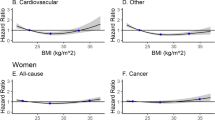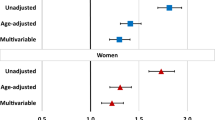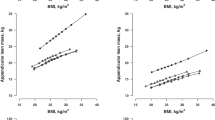Abstract
Objective:
Body mass index (BMI) is associated with increased incidence of cardiovascular disease (CVD). However, the risk could be very different for individuals with the same body mass. The present study explored whether regional fat distribution, as measured by waist–hip ratio (WHR), could modify the impact of BMI on the risk of CVD in men and women.
Design:
Prospective population-based study.
Subjects:
A total of 10 369 men and 16 638 women, 45–73 years old, from general population in Malmö, Sweden.
Measurements:
All subjects were followed over 7 years for the incidences of first-ever cardiac event (CE) and ischemic stroke in relation to BMI category (<25.0, 25.0–29.9, ⩾30.0) and WHR.
Results:
The prevalence of overweight and obesity was 39.4 and 13.0%, respectively. During follow-up, 1280 subjects suffered a CVD event (750 CE, 530 ischemic stroke). The risk of CVD in women increased with increasing levels of WHR, irrespective of BMI category. In men, WHR (per 1 s.d. increase) was associated with increased incidence of CVD in those with normal weight (relative risk (RR)=1.24; 95% CI: 1.13–1.37) after adjustments for confounding factors. However, WHR was not related to CVD in overweight men (RR=1.06; 95%CI: 0.94–1.20) or obese men (RR=1.04; 95%CI: 0.87–1.24). A significant interaction was observed between sex and WHR on the CVD risk.
Conclusion:
The effect of WHR on incidence of CVD is modified by the overall body weight and by gender. WHR adds prognostic information on the cardiovascular risk in women at all levels of BMI, and in men with normal weight.
This is a preview of subscription content, access via your institution
Access options
Subscribe to this journal
Receive 12 print issues and online access
$259.00 per year
only $21.58 per issue
Buy this article
- Purchase on Springer Link
- Instant access to full article PDF
Prices may be subject to local taxes which are calculated during checkout


Similar content being viewed by others
References
Kannel WB, Wilson PW, Nam BH, D'Agostino RB . Risk stratification of obesity as a coronary risk factor. Am J Cardiol 2002; 90: 697–701.
Zhou BF . Effect of body mass index on all-cause mortality and incidence of cardiovascular diseases – report for meta-analysis of prospective studies open optimal cutoff points of body mass index in Chinese adults. Biomed Environ Sci 2002; 15: 245–252.
Jonsson S, Hedblad B, Engström G, Nilsson P, Berglund G, Janzon L . Influence of obesity on cardiovascular risk. Twenty-three-year follow-up of 22 025 men from an urban Swedish population. Int J Obes Relat Metab Disord 2002; 26: 1046–1053.
Engstrom G, Hedblad B, Stavenow L, Jonsson S, Lind P, Janzon L et al. Incidence of obesity-associated cardiovascular disease is related to inflammation-sensitive plasma proteins: a population-based cohort study. Arterioscler Thromb Vasc Biol 2004; 24: 1498–1502.
Dalton M, Cameron AJ, Zimmet PZ, Shaw JE, Jolley D, Dunstan DW et al. AusDiab Steering Committee. Waist circumference, waist-hip ratio and body mass index and their correlation with cardiovascular disease risk factors in Australian adults. J Intern Med 2003; 254: 555–563.
Lakka HM, Lakka TA, Tuomilehto J, Salonen JT . Abdominal obesity is associated with increased risk of acute coronary events in men. Eur Heart J 2002; 23: 706–713.
Rexrode KM, Carey VJ, Hennekens CH, Walters EE, Colditz GA, Stampfer MJ et al. Abdominal adiposity and coronary heart disease in women. JAMA 1998; 280: 1843–1848.
Berglund G, Elmståhl S, Janzon L, Larsson SA . Design and feasibility. J Intern Med 1993; 233: 45–51.
Manjer J, Carlsson S, Elmstahl S, Gullberg B, Janzon L, Lindstrom M et al. The Malmo Diet and Cancer Study: Representativity, cancer incidence and mortality in participants and non-participants. Eur J Cancer Prev 2001; 10: 489–499.
Li C, Engstrom G, Hedblad B, Berglund G, Janzon L . Blood pressure control and risk of stroke: a population-based prospective cohort study. Stroke 2005; 36: 725–730.
Wallstrom P, Wirfalt E, Janzon L, Mattisson I, Elmstahl S, Johansson U et al. Fruit and vegetable consumption in relation to risk factors for cancer: a report from the Malmo Diet and Cancer Study. Public Health Nutr 2000; 3: 263–271.
Royal College of Psychiatrists. Alcohol: Our Favorite Drug 1986. Tavistock: London.
World Health Organization. Obesity: preventing and managing the global epidemic. WHO: Geneva, 1997. Report of a WHO consultation on obesity, WHO/NUT/NCD 98.1.
The National Board of Health and Welfare. Centre of Epidemiology. Myocardial infarction in Sweden 1987–2000. (In Swedish: Hälsa och Sjukdomar) Social-styrelsen 2003; 4.
The National Board of Health and Welfare. Centre of Epidemiology. Causes of Death 1995. Stockholm: Sweden, 1997.
Jerntorp P, Berglund G . Stroke registry in Malmö. Stroke 1992; 23: 357–361.
Carey DG . Abdominal obesity. Curr Opin Lipidol 1998; 9: 35–40.
Brook RD, Bard RL, Rubenfire M, Ridker PM, Rajagopalan S . Usefulness of visceral obesity (waist/hip ratio) in predicting vascular endothelial function in healthy overweight adults. Am J Cardiol 2001; 88: 1264–1269.
Willett WC . Guidelines for healthy weight. N Engl J Med 1999; 341: 427–434.
McCarty MF . A paradox resolved: the postprandial model of insulin resistance explains why gynoid adiposity appears to be protective. Med Hypotheses 2003; 61: 173–176.
Despres JP, Lemieux I, Prud'homme D . Treatment of obesity: need to focus on high risk abdominally obese patients. BMJ 2001; 322: 716–720.
Folsom AR, Prineas RJ, Kaye SA, Munger RG . Incidence of hypertension and stroke in relation to body fat distribution and other risk factors in older women. Stroke 1990; 21: 701–706.
Rexrode KM, Buring JE, Manson JE . Abdominal and total adiposity and risk of coronary heart disease in men. Int J Obes Relat Metab Disord 2001; 25: 1047–1056.
Kvist H, Chowdhury B, Sjostrom L, Tylen U, Cederblad A . Adipose tissue volume determination in males by computed tomography and 40 K. Int J Obes Relat Metab Dis 1988; 12: 249–266.
Kvist H, Sjostrom L, Tylen U . Adipose tissue volume determinations in women by computed tomography: technical considerations. Int J Obes Relat Metab Disord 1986; 10: 53–67.
Bjorkelund C, Lissner L, Andersson S, Lapidus L, Bengtsson C . Reproductive history in relation to relative weight and fat distribution. Int J Obes Relat Metab Disord 1996; 20: 213–219.
Haffner SM, Katz MS, Dunn JF . Increased upper body and overall adiposity is associated with decreased sex hormone binding globulin in postmenopausal women. Int J Obes Relat Metab Disord 1991; 15: 471–478.
Janzon E, Hedblad B, Berglund G, Engstrom G . Changes in blood pressure and body weight following smoking cessation in women. J Intern Med 2004; 255: 266–272.
Katzmarzyk PT, Perusse L, Malina RM, Bouchard C . Seven-year stability of indicators of obesity and adipose tissue distribution in the Canadian population. Am J Clin Nutr 1999; 69: 1123.
Acknowledgements
This study was supported by grants from the Heart and Lung Foundation, and the Segerfalk Fund. We thank Swedish Cancer Society, Swedish Society for Hypertension, Swedish Medical Research Council and Scania Regional Government.
Author information
Authors and Affiliations
Corresponding author
Rights and permissions
About this article
Cite this article
Li, C., Engström, G., Hedblad, B. et al. Sex differences in the relationships between BMI, WHR and incidence of cardiovascular disease: a population-based cohort study. Int J Obes 30, 1775–1781 (2006). https://doi.org/10.1038/sj.ijo.0803339
Received:
Revised:
Accepted:
Published:
Issue Date:
DOI: https://doi.org/10.1038/sj.ijo.0803339
Keywords
This article is cited by
-
Sex-related change in BMI of 15- to 16-year-old Norwegian girls in cross-sectional studies in 2002 and 2017
BMC Pediatrics (2019)
-
Body mass index is an independent predictive factor for kidney function evaluated by glomerular filtration rate in a community-dwelling population
Eating and Weight Disorders - Studies on Anorexia, Bulimia and Obesity (2019)
-
Body mass index and metabolic factors predict glomerular filtration rate and albuminuria over 20 years in a high-risk population
BMC Nephrology (2013)
-
Novel and established anthropometric measures and the prediction of incident cardiovascular disease: a cohort study
International Journal of Obesity (2013)
-
European Guidelines on Cardiovascular Disease Prevention in Clinical Practice (Version 2012)
International Journal of Behavioral Medicine (2012)



